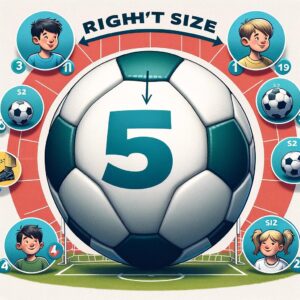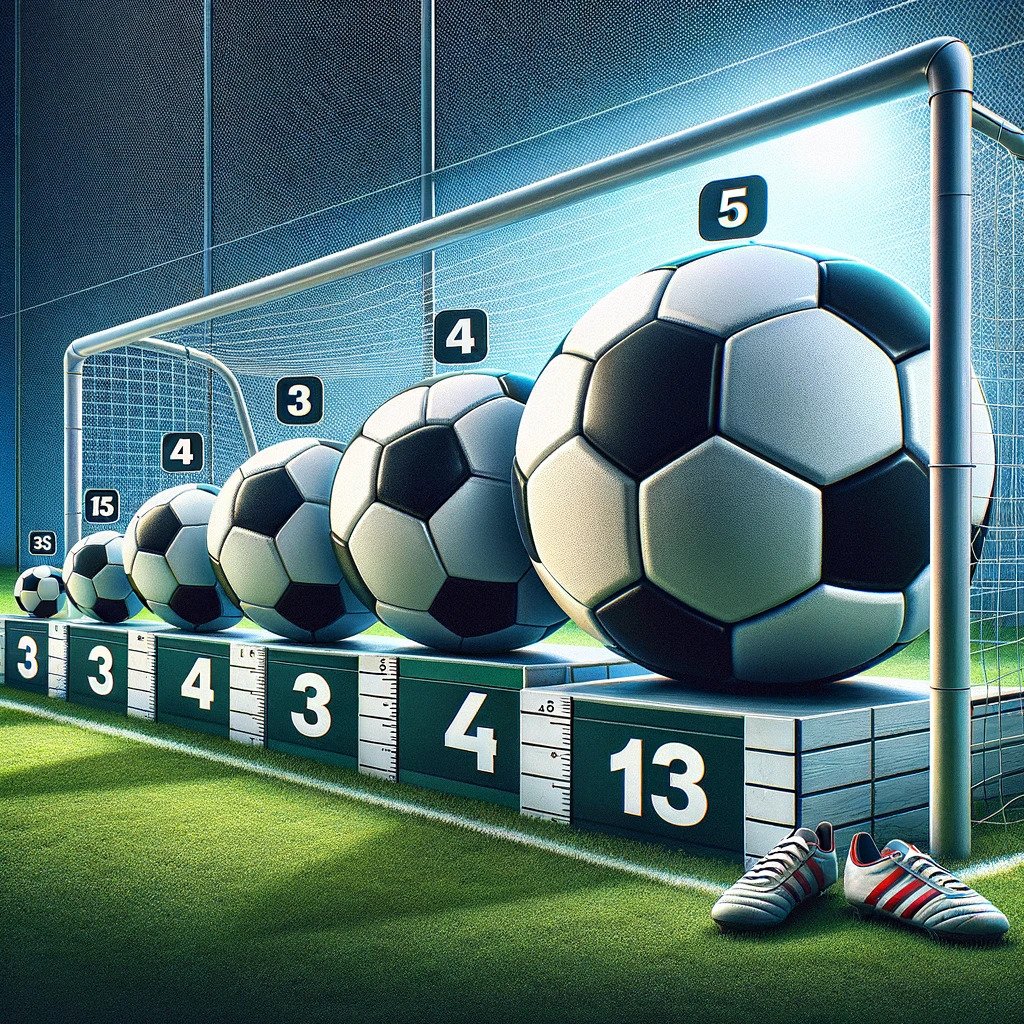As a coach who has seen many young athletes grow in their soccer journey, I can surely attest that choosing the right ball size is not just about the game, but about nurturing their skills. Remember, a soccer ball isn’t just a piece of equipment; it’s a crucial part of the learning curve. When we talk about a 13-year-old, we’re looking at a specific age group where skill development is significant.
In the world of soccer, different sizes of balls are designed for various age groups. It’s important to understand that a child at a certain age shouldn’t be playing with a size 2 ball. Instead, for a 13-year-old, a size 5 ball is recommended. This is not just an example but a rule of thumb. The reasons are many – from ensuring safety to enhancing ball control. I wouldn’t want to see a young player use the wrong size, hampering their growth and love for the game.
Through this guide, we will cover the essentials of selecting the appropriate soccer ball. Whether you’re a parent or a coach, knowing which ball size is right for your youth players is essential. Let’s choose wisely and foster a positive and effective learning environment for our budding soccer stars.
Soccer Ball Sizes explained
When selecting a soccer ball for a 13-year-old, understanding the sizes and their development stages is crucial. Here’s a breakdown of the soccer ball sizes and their appropriate ages.
Size 1
Size 1 balls, measuring 18-20 inches in circumference, are the smallest available. Ideal for children aged 3 and under, they’re perfect for those anxious to start kicking a ball. Due to their smaller size and weight, they’re great for indoor play and won’t break much in the house. They’re also used for technical training to improve touch and control. Moreover, teams often give away these balls as souvenirs, featuring player or club logos.
Size 2
Size 2 balls are for ages 3-5 years old and have a circumference of 20-22 inches, weighing 250-280 grams. This size is the least standard and often overlooked in youth programs, which default to Size 3. However, it’s recommended for toddlers and preschoolers and finds a market among older players for skills practice like juggling and tricks. These are also popular in clubs for promotional balls.
Size 3
Size 3, for ages 5-8 years old, is often where many teams start. It’s the first real game-size ball used in matches and leagues, especially rec leagues that play from U6 onwards. With a circumference of 23-24 inches and weight of 300-320 grams, it’s larger and heavier than Size 2 but lighter and smaller than Sizes 4 and 5. This size encourages proper handling and control for young players, helping them gain confidence and develop their skill base.
Size 4
Size 4 is for ages 8-12 years old, with a circumference of 25-26 inches and weight of 350-390 grams. This size is designed for youth players making the transition in their soccer skills and development. It’s slightly smaller and lighter than Size 5, making it easier for players to control and move during practices and matches.
Size 5
Finally, Size 5 is the most commonly used ball, suited for older players, including adults and professionals. It’s heavier than the other sizes, weighing 410-450 grams and measuring 27-28 inches in circumference. It’s recommended for players 12 years old and older.
Due to its heavier weight, it’s difficult for younger children to kick and pass, potentially becoming a safety hazard. The muscles and tendons of younger players may not be ready for this weight. For official matches, it’s important to use Size 5 balls that are FIFA Approved or FIFA Inspected, as these have been tested to be the official size and weight.
In summary, each soccer ball size has a unique role in a young player’s journey, from Size 1 for the youngest kickers to Size 5 for aspiring professionals. It’s essential to choose the right size for safe and effective skill development.
Different soccer ball sizes by age
The table below succinctly captures the different soccer ball sizes along with the corresponding age groups and key characteristics, making it an efficient resource for anyone looking to understand the appropriate ball size for young players.
| Size |
Age Group |
Description |
| 1 | Toddler | Mini balls or skill balls used for training players in skill development and ball control. Suitable for anyone, regardless of age, to improve skills. |
| 2 | 3-5 years | Known as “skills balls” or “trainer balls”. Ideal for honing ball control, footwork, and recommended for kids ages 3 to 5 and older players for drills. |
| 3 | 6-8 years | Typically used in junior-level games. Excellent for children under eight, including kindergarten students, as it encourages proper handling and is safe. |
| 4 | 8-12 years | Acts as a buffer between small and huge balls. Suitable for youth soccer players, helping them become more comfortable with their skill sets. |
| 5 | 12+ years | The professional standard. Used by players aged 12 and up, including adults in regular, elite, and international matches. Not intended for newcomers to the sport. |
Purpose behind soccer ball sizes
When choosing a soccer ball for a 13-year-old, especially for practice rather than playing, understanding the purpose behind different ball sizes becomes crucial. Practice balls, distinct from those used in official matches, are made specifically to accommodate the unique needs of training.
They differ in characteristics such as air retention, form, water absorption, slope, and trajectory. This differentiation ensures that young players can train effectively without the complexities of a match ball, which might be too advanced for their current skill level.
Furthermore, the construction and features of balls intended for different environments like indoor, pool, and street also vary significantly. While indoor balls are designed to have less rebound to suit enclosed spaces, pool balls are crafted to resist water, and street balls are built to endure rough surfaces.
These variations emphasize the importance of selecting the right ball not only based on size but also based on the training environment to ensure the best possible development and enjoyment for young players.
Does size of a soccer ball matters?
Knowing the correct size of a soccer ball for a child is more than essential; it’s necessary to prevent potential injuries. A ball that’s not the right size can possibly lead to injury, especially in youth players. For instance, if a young player kicks a size five ball, which is made for adults, on a daily basis, they are bound to sustain an injury. This is because a size five ball is designed with adult players in mind, taking into account the pressure and diameter suitable for their physical capabilities.
It’s not just about escaping injuries; a child might want a ball that offers the right bounce and weight for their other required exercises and skill development. Therefore, while professional soccer players often play with a size 5 pitch, they also utilize different sizes for skill development. These varied sizes are tailored to enhance specific skills and ensure safe, effective training for players of all ages, particularly those in the crucial growth stages of soccer.
What Size Soccer Ball is Right for 13 year old?

For a 13-year-old soccer player, the ideal choice is a size 5 ball. This size is the standard for players aged 12 and up, matching the specifications used by professional players. The size 5 ball, with its circumference of 27-28 inches and a weight of 14-16 ounces, aligns with the physical capabilities and needs of this age group.
When choosing a ball, it’s important to consider the player’s skill level and playing style. For those starting out, a lighter ball might be easier to control, while more experienced players may benefit from a heavier ball that can provide more power and accuracy in their play.
Additional Considerations for Soccer Ball Selection
Beyond just size, there are additional tips for picking the right soccer ball. It’s important to choose a ball made of durable materials, such as leather or synthetic leather, which can withstand regular use. Make sure the ball is properly inflated to the correct pressure, as this affects performance. Allow the ball to break in before using it in a game, as this can improve how it handles.
For players seeking better command over the ball, Consider purchasing a ball with a soft touch feature for better control. This can significantly aid in developing more refined soccer skills.
Conclusion
Selecting the right size soccer ball for a 13-year-old is a crucial decision that influences their development and enjoyment of the game. The standard size 5 ball, with its specific dimensions and weight, is ideally suited for players in this age group, balancing the need for control, power, and technical skill development.
Additionally, factors such as material durability, proper inflation, and a soft touch for better control are essential considerations. By paying attention to these details, parents and coaches can provide young soccer enthusiasts with the best tools to grow in their sport, ensuring a positive and progressive experience on the soccer field.
Frequently asked questions
What size soccer ball for 8 year olds?
For 8 year olds, a size 4 soccer ball is recommended. This size is ideal for children in this age group, offering a suitable balance for skill development and play.
What size soccer ball for 10 year old boys?
A 10 year old boy should use a size 4 soccer ball. This size provides the right proportion for their physical capabilities, aiding in skill improvement and game enjoyment.
What size soccer ball for 7th grade girls?
Seventh-grade girls, typically aged 12-13 years, should use a size 5 soccer ball. This size is the standard for players aged 12 and up and aligns with professional soccer standards.
What size soccer ball for 5 year olds?
For 5 year olds, a size 3 soccer ball is the best choice. It’s appropriately scaled for their smaller size and helps in developing basic soccer skills.
What size soccer ball for 9 year olds?
Nine-year-olds should play with a size 4 soccer ball. It’s an ideal size for their developmental stage, facilitating better control and skill development.
What’s the right air pressure for a youth soccer ball?
The recommended air pressure for a youth soccer ball is typically around 0.6 – 1.1 bar (8.5 – 16 psi). Always check the ball’s specifications for the exact pressure range.
What size is a Futsal ball?
A Futsal ball is typically a size 4, but it is heavier and has less bounce compared to a regular soccer ball of the same size. This design is specific to the sport of Futsal.

